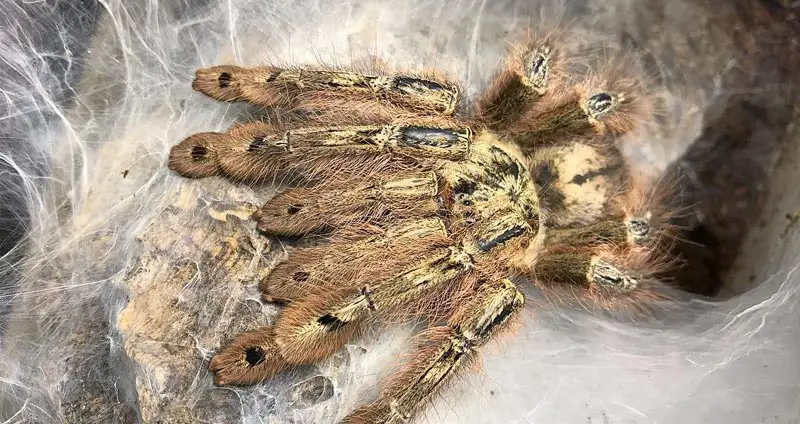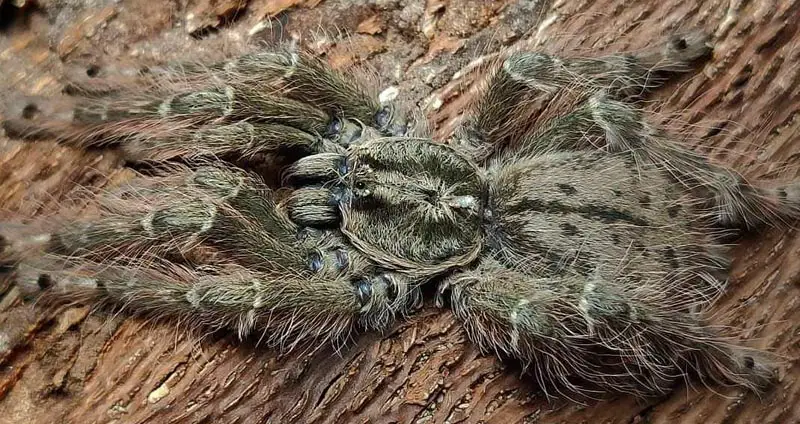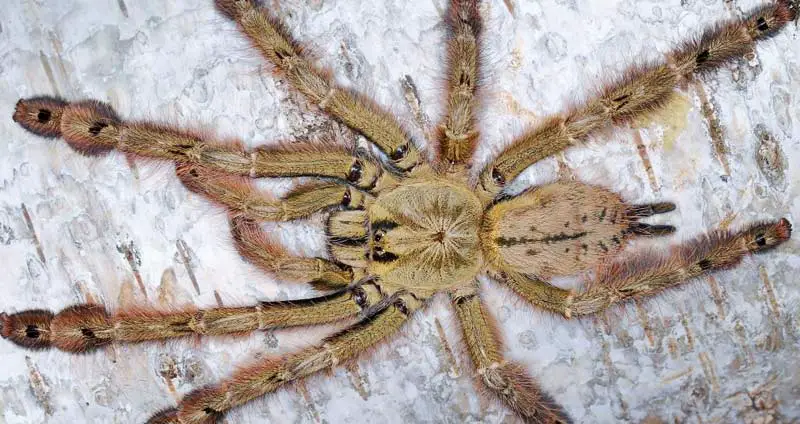Stromatopelma calceatum, also known as the Feather Leg Baboon Tarantula, is one of the most defensive, dangerous, and fast-moving tarantulas out there today.
If you’re a beginner keeper, turn away now. This tarantula species should only be kept by experienced keepers. Anything less could spell disaster.
This care sheet will tell you everything that you need to know about this incredible tarantula, including how to properly feed, house, and act near it.
Table of Contents
Stromatopelma calceatum Care Sheet
| Common Name |
Feather Leg Baboon |
| Species Type | Old world arboreal |
| Habitat | Widely distributed throughout West Africa where it’s consistently warm and humid. |
| Growth Rate | Fast growth rate, reaching maturity in just a few years. |
| Adult Size | Females reach a legspan of over 6″ while males measure right around 6″. |
| Lifespan | Females live for between 12 and 15 years, while males often only live for 4 years. |
| Enclosure | The enclosure needs to be taller than it is wide with about 2 inches of substrate on the ground. Vertical climbing structures should be present, as should a water dish. |
| Temp/Humidity | 75°F to 80°F with about 70% to 80% humidity. |
| Diet | Great eater that can eat several adult crickets per week. |
| Temperament | Very defensive and aggressive. Doesn’t always start a fight, but will readily defend itself. Within its enclosure, it’s decently energetic and climbs/digs frequently. |
| Experience Level | Advanced – This spider is only for professionals with plenty of experiencing caring for fast, aggressive tarantulas. Fun to own, but very dangerous. |
| Average Cost | Slings ~ $30, Males ~ $70, Females ~ $100+ |
Stromatopelma calceatum Appearance
While the appearance of this tarantula isn’t necessarily flashy or colorful, it’s very eye-catching and easy to identify. This is a common trend among baboon tarantulas.
Most females are covered in a dark sandy-brown color with clay-colored setae covering the body. Then, they feature a very unique pattern of almost metallic black markings on their legs, carapace, and abdomen.
Males have gray bodies with darker grey markings.
I would describe the pattern as chipped-away paint that reveals the bare metal underneath. Some S. calceatum will have much more prominent patterns, though — especially on the legs.
In terms of sizing, this is an average tarantula. Females typically grow to have a legspan just over 6″, while males measure slightly smaller. Their growth rate is quite fast, as they reach this size in just a few years.
As spiderlings, they start out relatively indistinct, but this coloration and pattern quickly develops.

Stromatopelma calceatum Temperament
The temperament of this tarantula is what makes it so dangerous yet so desirable. There aren’t many other species that strike fear into people like this one.
Stromatopelma calceatum is an old world tarantula, which are tarantulas that are known for their aggressive/defensive personalities and their possession of very potent venom.
The Feather Leg Baboon Tarantula is no exception to this classification. It’s known as a very fast-moving, aggressive, defensive tarantula that possesses some of the most potent venom out of all tarantulas!
Don’t think that this tarantula is out for blood, though. Most owners will tell you that theirs is defensive, sure, but isn’t actively seeking to fight/bite. The dangerous part of these tarantulas is their unpredictability.
Some owners have had their S. calceatum dart out of their enclosure before they could react. With venom that can easily put a person in the hospital, this could end very badly.
When they’re actually in their enclosure, though, they’re pretty interesting tarantulas. They’re arboreal species but have been seen creating shallow burrows and rearranging decorations.
So, in short, this is an incredibly interesting tarantula that clearly needs to be left to the pros.
Housing Stromatopelma calceatum
If you want to bring home this tarantula, you need to make sure that you have its enclosure fully completed and ready to go. As this is a defensive tarantula, you’ll want to interact with its enclosure as infrequently as possible.
Fortunately, creating the optimal enclosure doesn’t involve much more than getting the best tarantula terrarium and filling it with a few essentials.
Optimal Enclosure
As these are arboreal tarantulas with a strong desire to climb, providing them with a standard arboreal enclosure is optimal.
Arboreal tarantula enclosures focus on providing plenty of vertical space for a tarantula to climb and web up. There should be adequate floor space as well, but it should be taller than it is wide.
The absolute best enclosure for this species will have excellent ventilation, visibility, accessibility, and plenty of space to climb. It’s always better to go larger than smaller if you’re unsure of what size to get.
The recommended enclosure for a mature Stromatopelma calceatum is the Exo Terra 18” x 18” x 24” glass terrarium. There are more affordable options available, but you need to be sure that they are breathable, secure, and large enough.
Enclosure Decorations
While the terrarium itself is a very important aspect of the enclosure, interior accessories also need to be considered. There are a few supplies that S. calceatum requires.
First and foremost, there needs to be about 3 inches of moisture-retaining substrate lining the bottom of the enclosure. This substrate works to provide comfort, structure, humidity retention, and a place to dig.
While this is an arboreal species, it has been observed digging into the substrate, so 3 inches should be enough for them.
From the substrate, you’ll want to build upward to create a tree-like environment. We recommend a large piece of cork bark that’s placed against one of the walls. A sizable hide and a fake plant or two should also be provided.
It’s also very important that you supply a water dish for your tarantula. This not only works to prevent dehydration, but it also maintains humidity within the enclosure.

Enclosure Temperature/Humidity
While tarantulas are hardy creatures, especially this tough arboreal species, it’s best to match their enclosure’s climate to the climate of their geographic origin.
Stromatopelma calceatum is widely distributed throughout West Africa, which is a region that’s quite hot and humid year-round. Fortunately, this is easy to translate into an enclosure.
The optimal temperature for this species is 75°F to 80°F, which is around room temperature for most people. Therefore, supplemental heating usually isn’t required.
If your house drops below this range frequently, you may need to use either a space heater or a very gentle heat lamp that doesn’t emit any light.
For humidity, aim for a range of 70% to 80%. This isn’t hard to maintain through the use of a water dish and by misting half of the substrate about 3 times per week. Don’t allow the substrate to get swampy, though.
It’s recommended that you use a thermometer/hygrometer so that you can monitor environmental conditions and make changes as needed.
Diet
Unsurprisingly, this aggressive tarantula has an equally aggressive appetite. You can frequently observe your Stromatopelma calceatum attacking its prey with a vengeance and quickly taking it down.
As spiderlings, these tarantulas will eat a mixture of flightless fruit flies and pinhead crickets. As they mature, though, you can switch to feeding them adult crickets and dubia roaches.
6 adult crickets or 2 dubia roaches per week seems to be the optimal amount to feed this species. However, feeding can vary greatly between specimen, so pay attention to your individual tarantula.
Health Concerns
Tarantulas that are kept as pets aren’t very needy and don’t experience a lot of health problems. As long as their enclosure is optimal and their diet is complete, there’s a good chance that they’ll live a long and healthy life.
Captive tarantulas do have two semi-common problems that they can encounter, though — dehydration and parasites/mites. Both of these issues are easy to cure and avoid altogether, though.
There are two other points that you need to consider regarding Stromatopelma calceatum.
First of all, this is an arboreal tarantula, so it needs to have plenty of space to climb. If its enclosure doesn’t meet its needs, its growth may be hindered and it may develop several other problems.
Additionally, this tarantula is fast and very unpredictable. This may be dangerous for the tarantula if they dart out of their enclosure and hit the floor.
Therefore, you should obviously never handle this tarantula or casually interact with it. Too many old world tarantulas lose their lives at the hands of irresponsible owners.
Stromatopelma calceatum For Sale & Price
While this tarantula is extremely dangerous and exciting, it’s surprisingly not an expensive tarantula. Its obscurity and inaccessibility for beginners results in cheap prices.
It’s not very easy to find this tarantula for sale, but it’s being sold on several online marketplaces for consistent prices. Spiderlings sell for around $30, males sell for $70, and females sell for $100+. Prices for mature tarantulas can vary greatly, but they’re still very cheap.
While there are other costs of tarantula ownership, it’s still relatively cheap to own one of these enticing tarantulas.
Don’t let this cheap price entice you if you’re inexperienced, though. Look for other types of tarantulas. Stromatopelma calceatum should only be kept by experienced tarantula enthusiasts. It’s beautiful but defensive and packs a huge punch with its bite.


Great post.